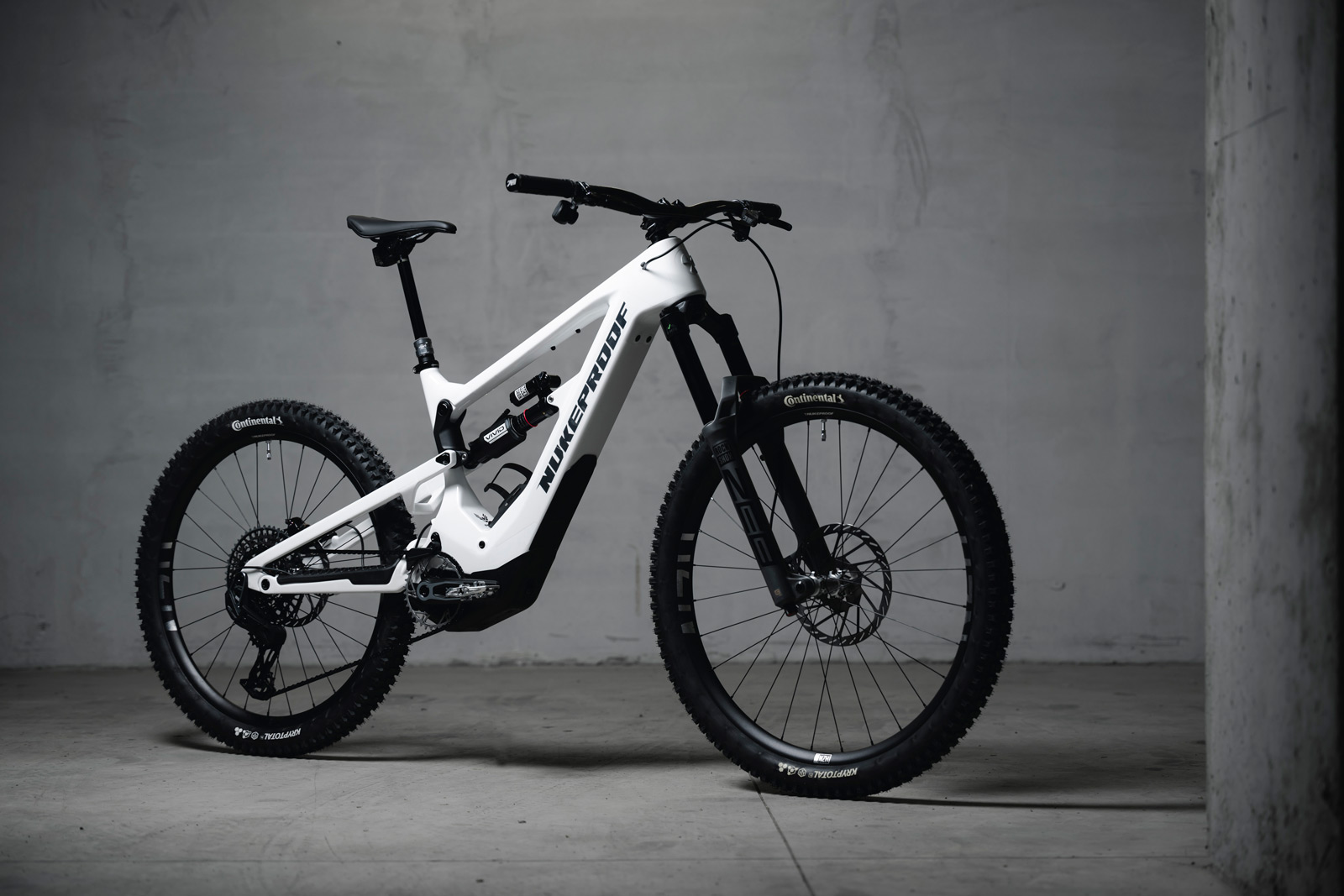The 2024 Nukeproof Megawatt is first across the line with the SRAM Powertrain eBike Motor system. It boasts a maximum torque of 90 Nm and 680 Watts peak power, working with a SRAM 720 Wh battery loaded into the downtube. A dedicated mullet platform, the Megawatt is a full carbon affair, pairing a 170mm fork with 172mm of rear wheel travel, on an eBike that is positively awash with the latest tech your money can buy.
Combined with a SRAM Transmission groupset, and the increasingly busy AXS Protocol, high-end features like auto-shifting and cost-shifting and readily available. This eBike is inter-connectivity defined.
Thanks to the Bike Connection Agency, we’ve been lucky enough to ride the 2024 Nukeproof Megawatt on some quite tricky, but equally enthralling, limestone singletrack in Andalo, Italy. Our thoughts on the SRAM Powertrain can be found elsewhere. Here, we dig into the details of Nukeproof’s latest eMTB, furnished with some comments on how it rides.
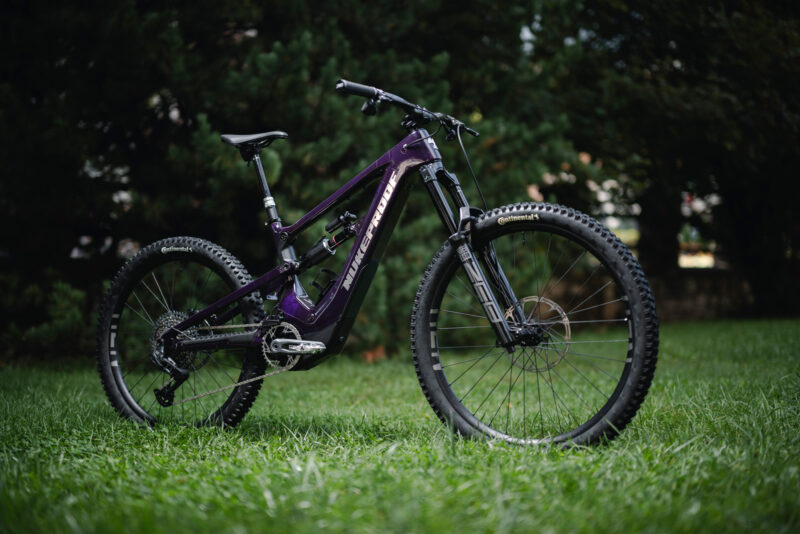
2024 Nukeproof Megawatt
- Bike: 2024 Nukeproof Megawatt eMTB
- Fork Travel: 170mm
- Rear Wheel Travel: 172mm
- Wheel Size: 29″ Front, 27.5″ Rear
- Size Availability: S-XXL
- Motor: SRAM Powertrain, powered by Brose
- Battery Capacity: 720 Wh
- Claimed Weight: 24.3 kg (PRO Model in Medium) // 24 kg (RS Model in Medium)
- Starting Price: $9,899 USD // 10,499.99 € // £8,799.99 – Megawatt PRO

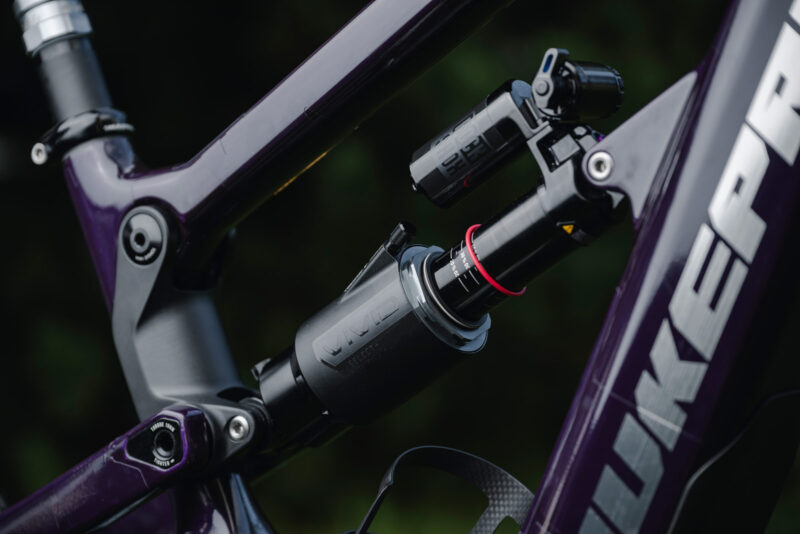
Nukeproof debuted the Megawatt in 2021, partnering with Shimano to bring the enduro-winning geometry of the Mega to anyone looking to improve their ratio of time-spent-descending to time-spent-ascending. For fans of aluminum, that bike isn’t going anywhere; it will remain in the stable as the more affordable option. The 2024 Megawatt brings to the table a carbon-framed, enduro-worthy eMTB that is sure to be irresistible to tech-adoring eBike fans.
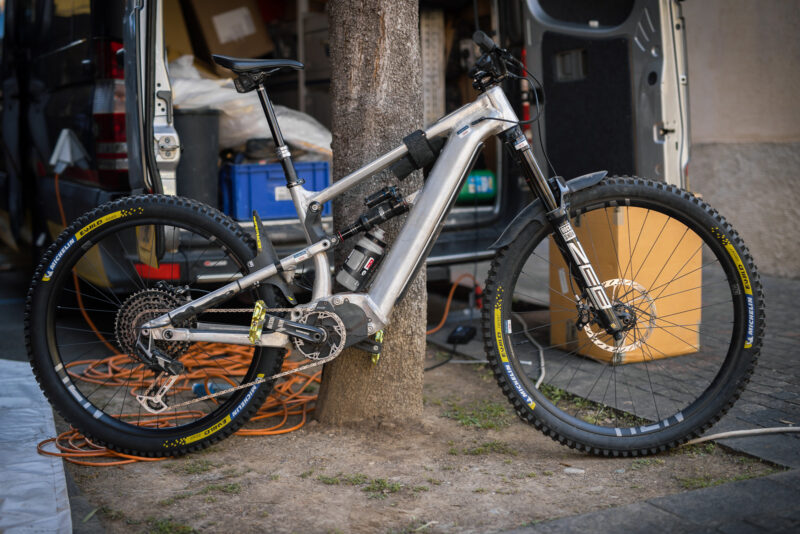
With the development of the new bike, maintaining the aluminum frame’s ride characteristics was a priority. The Belfast-based engineers were keen to not displace pivot locations too much to accomodate the Powertrain. The Northern Irish brand considers itself exceedingly lucky to have been involved in the development how the system integrates into a frame from very early on. Indeed, an earlier version of the system was raced during the 2022 EWS-E season as the engine room of an adapted aluminum Megawatt.
So, the 2024 Nukeproof Megawatt doesn’t represent too grand a departure from a proven geometry and kinematic.
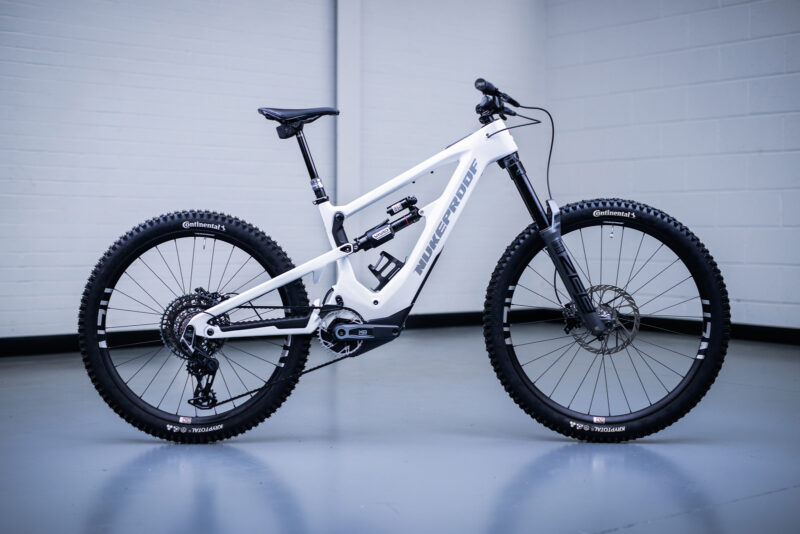
Geometry
The Megawatt Carbon is available in S-XXL frame sizes, accomodating a wide range of rider heights from 160 cm (5′ 3″) up to 198 cm (6′ 6″). Reach figures are equivalent to those seen on the aluminum Megawatt, at 475mm in a size large. But, overall, this is the lengthier eBike with a wheelbase of 1274mm in large. That’s thanks to chainstays that are 5mm longer, now at a consistent 447mm across the size range, and a slightly slacker head angle of 63.5°.
Seat tube length remains unchanged for S, M & L frames, pleasingly short at 380mm, 410mm and 440mm, respectively. The XL and XXL frames actually benefit from shorter seat tubes than the aluminum frame, at 460mm and 480mm, respectively.
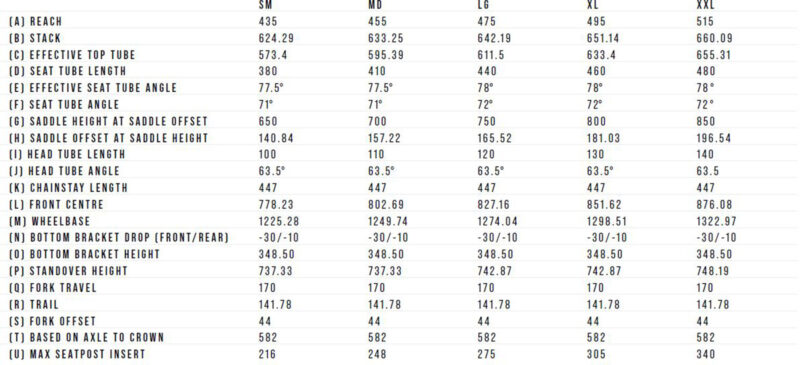
Unfortunately, taller riders don’t stand to reap the benefits of improved clearance if they stick with the AXS Reverb dropper post that is spec’d on the Megawatt Carbon RS and the Megawatt Carbon PRO models announced today. That’s because the longest version of the AXS Reverb offers just 170mm drop, significantly shorter than the drop lengths on offer from brands like OneUp and BikeYoke.
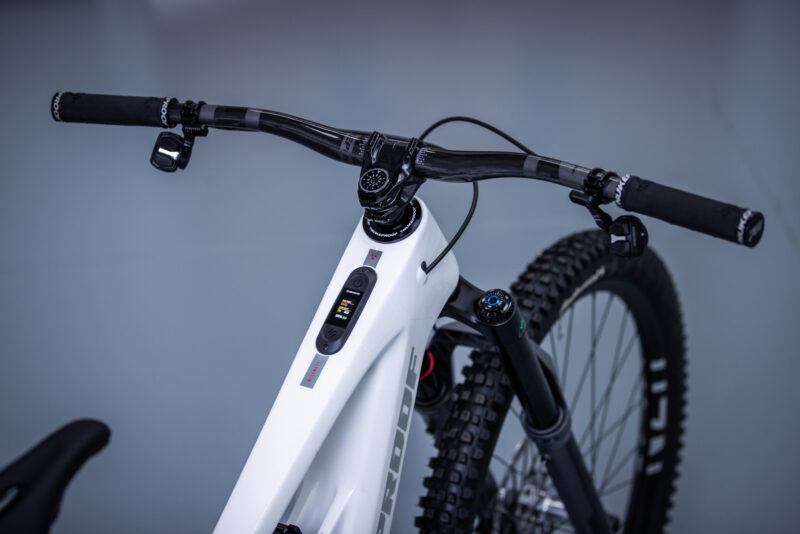
The advantage to running the AXS Reverb post is how it contributes to the ultra-clean cockpit. It is operated by the lower button on the left-hand Pod Controller. Using an alternative post will add another remote, the positioning of which may prove troublesome.
Nukeproof continue with relatively steep effective seat tube angles of 77.5° in S, M & L, steepening to 78° in XL & XXL. That offsets the rearward weight bias that would otherwise be emphasized for a taller rider. Nukeproof kindly provide (in the above geometry table) the exact saddle height at which they measure the effective seat tube angle for each frame size.
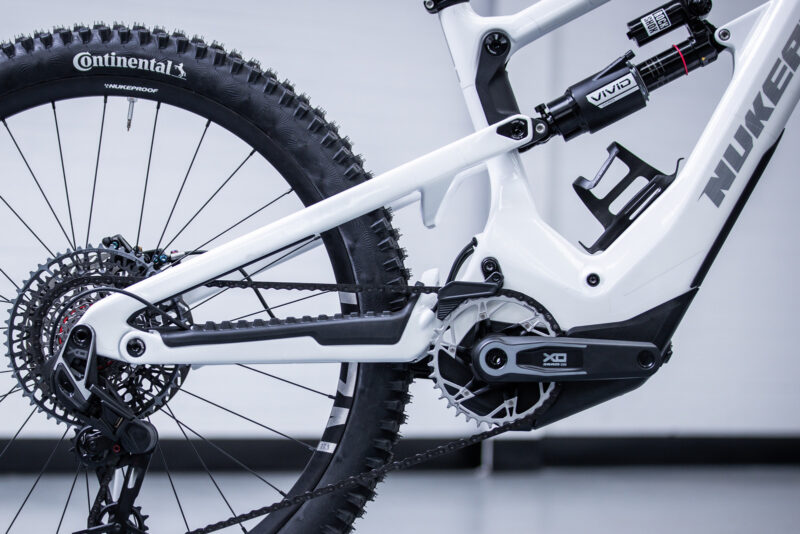
Kinematic
Nukeproof stay with the horst-pivot linkage design we’ve come to expect from the Mega and Megawatt bikes, with the pivot locations looking very familiar. As a result, alterations to the Megawatt’s kinematic are very subtle, but nevertheless meaningful.
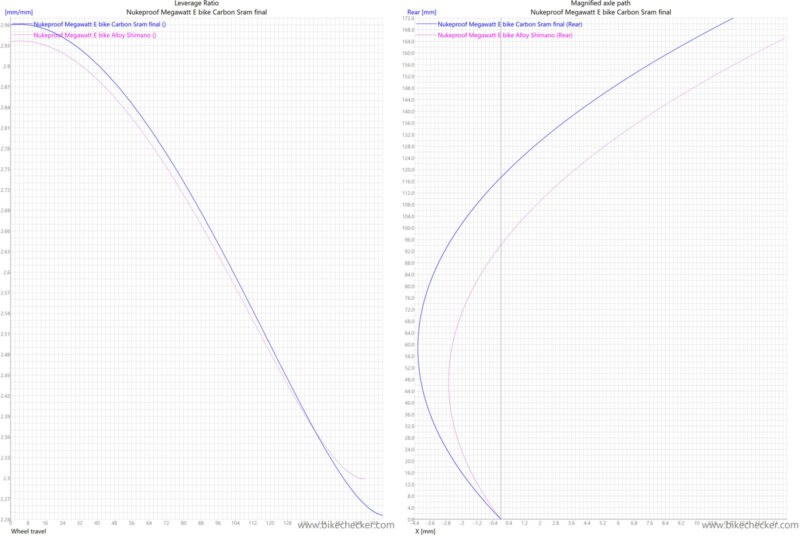
Travel is boosted from 170mm to 172mm, largely as the engineers were keen to add a little more progression to a frame that now, arguably, has a more capable set of geometry figures. The starting ratio is higher, delivering more off-the-top sensitivity, while the end ratio is lower, requiring more force to bottom-out the shock.
Overall progression is up from the 22% boasted by the alloy frame, to 24% on the carbon frame. Axle path is ever so slightly more rearward, lengthening the effective rear center length by around 4mm before the axle arcs forward again.
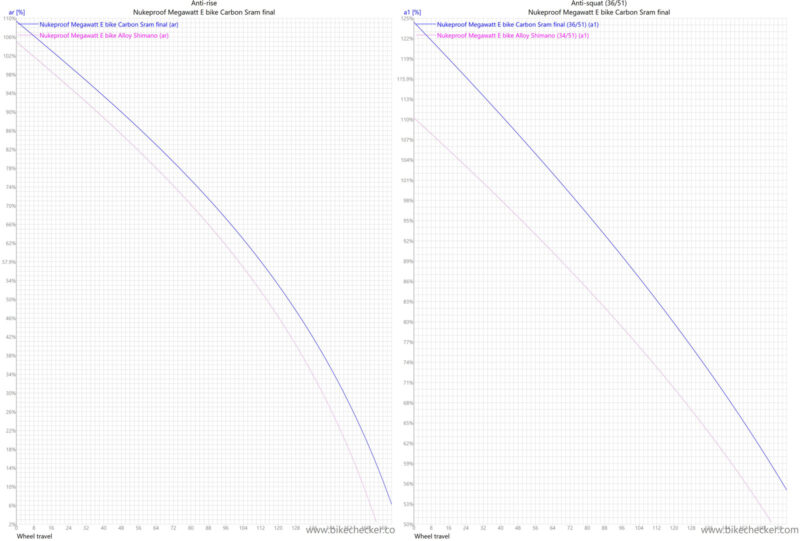
Anti-rise is relatively unchanged, sitting at around 90% at sag. It still drops off quite sharply as you go deeper into the travel. Anti-squat, on the other hand, is increased from 92% at sag, to 102% at sag (in the climbing gears). In theory, that should help the bike stay higher in its travel under the acceleration induced by pedaling forces.
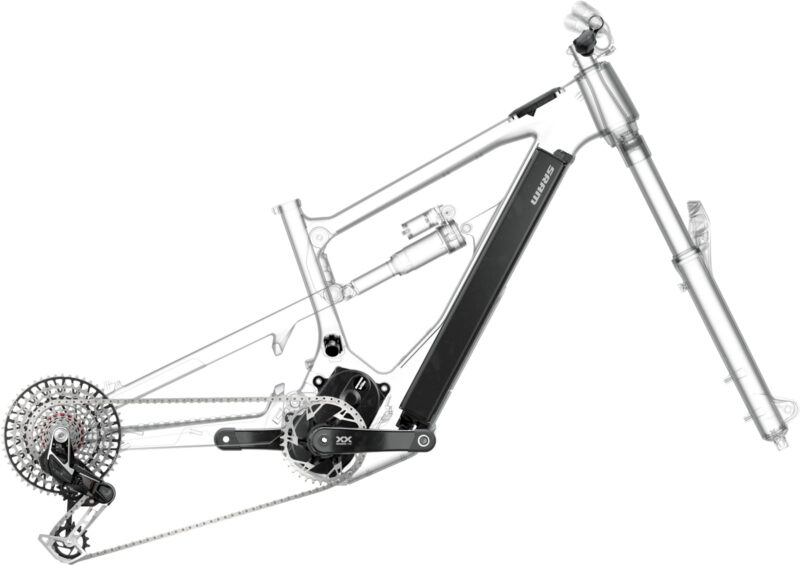
The Engine Room
The Megawatt Carbon is one of the more powerful eMTBs on the market, thanks to the 680 Watts peak power of the SRAM Powertrain motor. Maximum torque is 90 Nm, a tad higher than Shimano’s EP801 or Bosch Performance Line CX motors.
The motor has just two main riding modes; Range and Rally, both of which can be fine-tuned via the AXS App. There’s a Push Mode, too, that will drive the bike up to 6 km/h hour when the gradient becomes un-rideable. Switching modes is managed by the top button of the left-hand Pod Controller, but if that doesn’t suit you, you can also customize which button does what.

Bonus features of combining the SRAM Powertrain with Transmission are auto-shift and coast-shift. Indeed, the system will automatically shift for you as you ride along, taking into account your speed and pedaling cadence. Auto-shift can be tweaked to prioritize a cadence you feel most comfortable at – we go into greater detail on exactly how that works in our launch coverage of the Powertrain motor.
You can also over-ride it any time you want to shift manually. That way you can preempt a bit if you see a steep climb looming. Putting the rider back in complete control, auto-shift can also be switched off entirely.
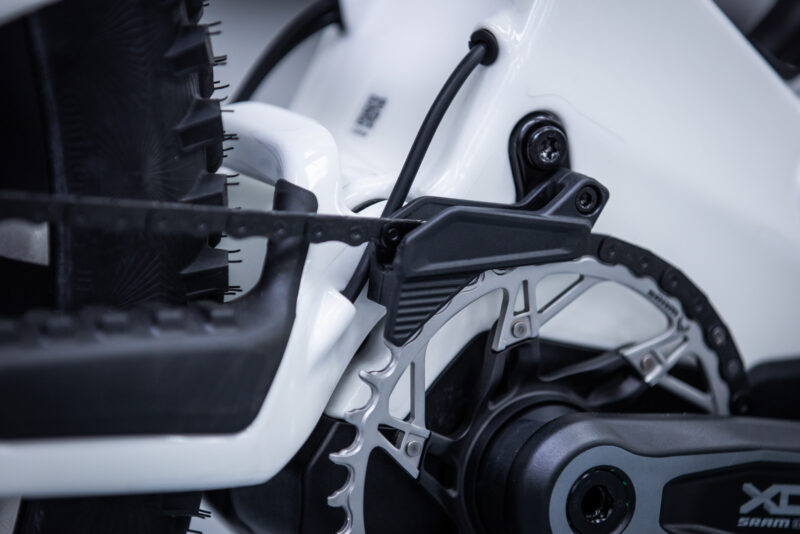
The coast-shift feature works as you might expect; the system can spin the chainring independently to the cranks as you’re coasting along, allowing the derailleur to shift the chain up or down the cassette to a gear ratio that better matches your speed. Our thoughts on that here, but here’s the spoiler; it’s nothing short of superb.

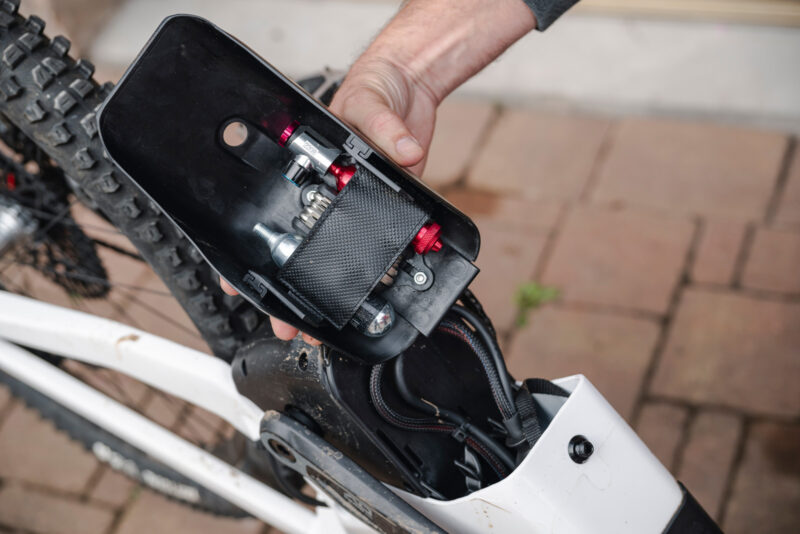
Frame Integration
SRAM offers a multitude of battery fitment options for both their 630 Wh and 720 Wh offerings. Nukeproof has gone for the 720 Wh battery, sliding it into the frame from the bottom of the downtube. This configuration is said to deliver a lighter and stiffer frame, as compared to a frame wherein the battery is removed via a large door on the underside of the downtube. The Megawatt is not compatible with SRAM’s 250 Wh range extender.
Nukeproof integrates the Powertrain system in a way that keeps weight positioned low. The motor is tilted upwards to allow the base of the battery to sit directly underneath it. To be fair, the packaging is pretty neat for such a big eBike, and all frame sizes can accomodate a 550 ml water bottle inside the front triangle as well. That increases to 620 ml if you use Nukeproof’s own water bottle.
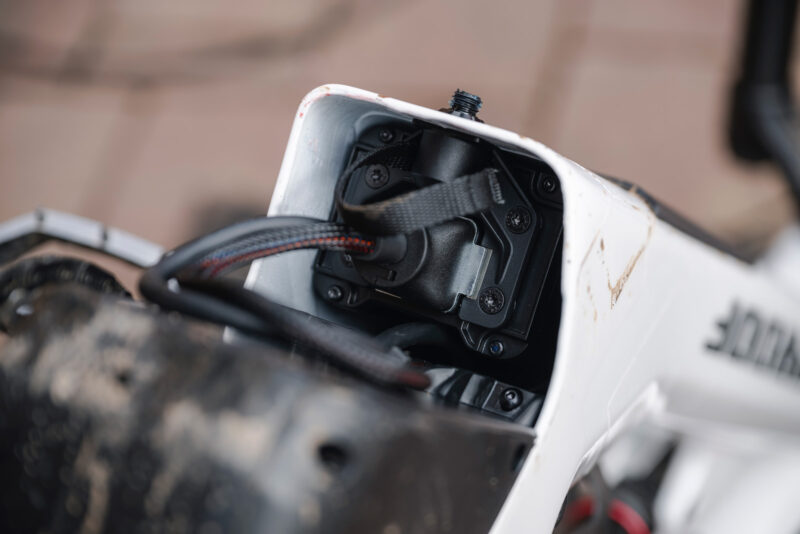
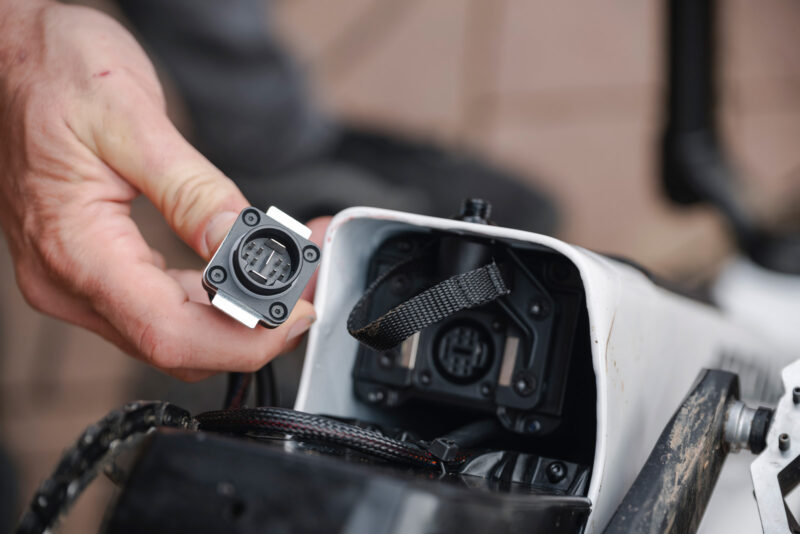
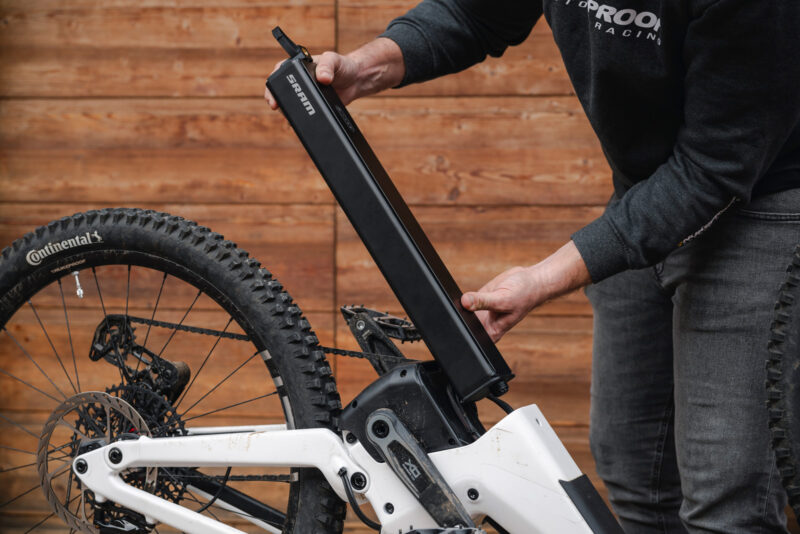
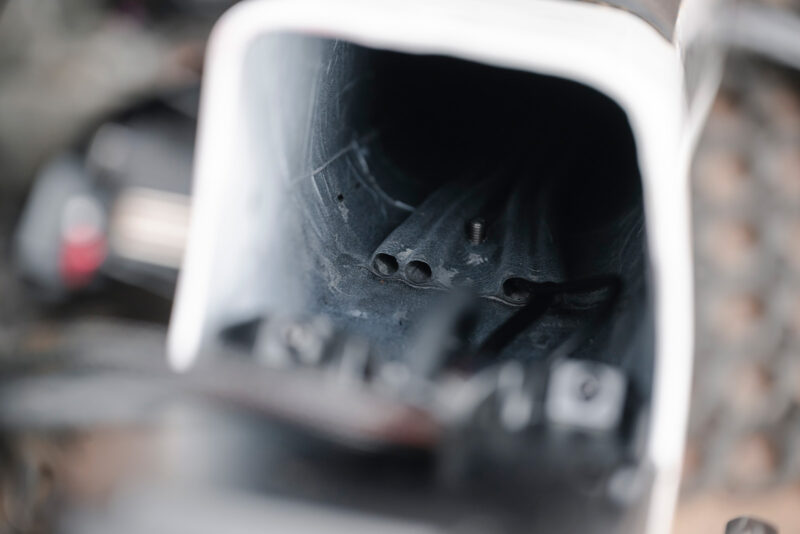
Inside the downtube are four full length cable guides, only two of which are actually in use on the two models launching today. One accommodates the rear brake hose, another the wire for the AXS Bridge Display Unit, another for the cable of a mechanical derailleur, and the final one for the routing of a mechanically-actuated dropper post. That’s tube-in-tube routing throughout the bike for all the accoutrements you could ever want.
Weight
Set up tubeless, without pedals, the medium Megawatt RS weighs a claimed 24 kg. For the Megawatt PRO model, claimed weight is 24.3 kg.

2024 Nukeproof Megawatt RS | First Ride Musings
Sans access to a small bike, I was provided with the 2024 Nukeproof Megawatt RS model in a size medium. According to Nukeproof’s size guide, at 163 cm tall, the medium is slightly too big for me. As such, my comments on how the bike rides will remain brief, and all of my ramblings should be considered within the context of this fact.
SRAM Powertrain
Regardless, I was keen to try out the SRAM Powertrain, so I wasn’t going to let a few millimeters of superfluous reach get in the way of that. I have given a detailed account of my impressions of the drive unit here, along with thoughts on the effectiveness of the auto-shift and coast-shift functions. I won’t reiterate too much of that here, but here’s a quick bullet-pointed summary.
Pros
- Power delivery is smooth, controlled and highly adjustable
- Auto-Shift is impressive and reliable over terrain where gradient does not change dramatically
- Coast-Shift is superb
Cons
- It’s easy to accidentally release Pod Controller button when using Push Mode
- Transmission isn’t able to shift fast enough when gradient tips up sharply
On the whole, I feel the system is excellent. Power delivery, set to 80% of the maximum (600 Watts) in the Rally mode, is smooth and easily controlled in steep, technical climbing scenarios. The bike’s relatively long chainstays (447mm), and steep (for an eBike) effective seat tube angle certainly help in that regard. As a result, it doesn’t require a monster effort to prevent the 63.5° head angle from wandering.
The motor is by no means silent, but is quieter than the Shimano EP801 motor that I had the pleasure of riding just the day before. If I were competing in an eMTB race, I would not use the auto-shift function. That’s because there is a short lag between the moment you want the next gear, and the moment the system gives it to you. That’s OK on a social ride, less so in a race situation. The coast-shift function I’d run all the time.
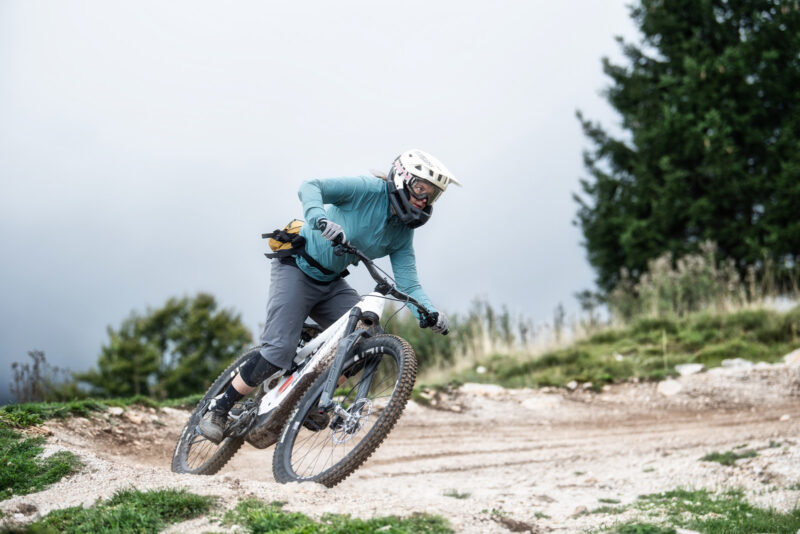
Test Bike Setup
Despite being quite an impressive tool for hurrying up hills, the Nukeproof Megawatt is still very much a descent-oriented eMTB. Our test bike, the Megawatt RS, is the top-end model, retailing at a lofty (but not out of this world) $10,899 USD.
The new RockShox Vivid Ultimate Air Shock damps 172mm of rear wheel travel, paired with a 170mm RockShox ZEB Ultimate fork. The bike rolls on a Nukeproof Horizon PRO aluminum wheelset (27.5″ rear, 29″ front). The medium gets a 150mm Rockshox AXS Reverb dropper post. When slammed into the seat tube, it delivered the perfect ride height for me.
It rolls on DH casing Continental Kryptotal tires – Super Soft up front, with the faster-rolling, more durable Soft compound on the rear. I ran 15 PSI in the front, and 19 PSI in the rear.
The fork was set to 52 PSI. I ran all external damping adjustment dials in the full open position. That’s the compression as soft as possible and the rebound as fast as possible. I have much experience with this fork, and know this setup delivers the most comfortable ride with the best traction for my 60 kg.
This was my first ride on the RockShox Vivid shock. As per Nukeproof’s recommendations, I set it to 30% sag (seated). Again, all compression and rebound damping was set to fully open to allow the shock to function in its most active state. The Vivid has another external adjustment for the Hydraulic Bottom Out. There are 5 settings; I ran the shock in the first position to give the least bottom-out resistance.
To counter the longer than optimal reach figure, I slammed the saddle forward on its rails, and the Nukeproof Horizon bar was swapped out for a higher rise option, rolled back a little to bring the reach in some more.
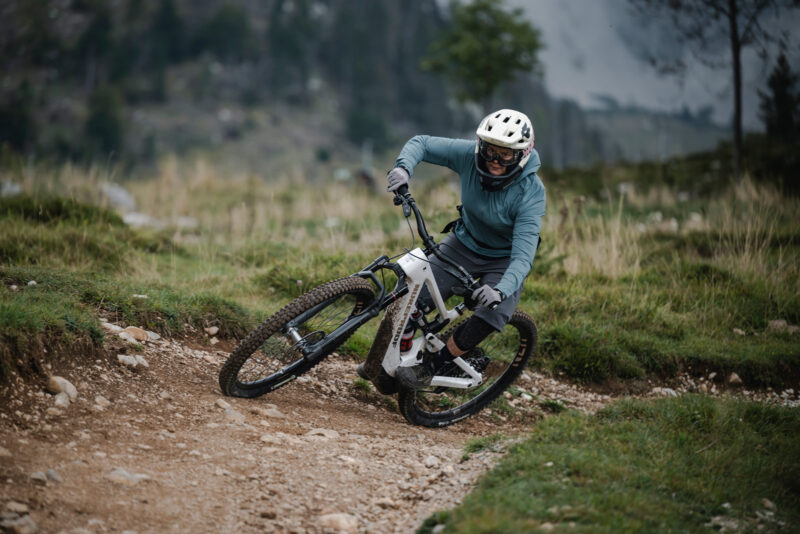
Descending
In the bike park, the size issue was most evident. Considering that, and with the fact that bike park riding isn’t really my bag, I have decided to withhold comment on that front.
However, bordering Andalo and the wider Paganella Bike Park are some challenging limestone singletrack descents. Some of these drop you over 1000 vertical meters to the valley floor. Some sections are narrow and rutted, filled with loose small to medium-sized rocks that shift underneath the tires. Other sections are more slab-like, but irregular, stepped and off-camber. It’s altogether very natural, and one must keep one’s wits about one.
The Megawatt Carbon seems to carry its weight well. It was relatively effortless to un-weight the front wheel over the damp limestone. Thanks to that, I felt far less vulnerable on this eBike than I have on the few others I’ve tested. It’s certainly one of the more confidence-inspiring eBikes i’ve ridden, particularly when it comes to very technical descents. That’s credit to the overall balance offered by the geometry on this medium frame.
Suspension Performance
As you might imagine, these trails are the perfect place to test suspension. And, the Nukeproof Megawatt RS did not let me down.
The rear end tracks beautifully through the chop, smoothing out the terrain incredibly well. Traction was plentiful. Despite my line choice occasionally being a little hectic, the bike pattered through the unpredictable rock gardens with little to no drama. For me, the fork was outperformed by the suppleness of the rear. What felt a little wild out front was effortlessly muted by the Vivid shock.
My experience has left me eager to test the RockShox Vivid shock on a regular mountain bike. All too often, I find that shocks are over-damped on the rebound circuit. That leads to packing down, a loss of suppleness, with feet occasionally losing contact with the pedals. This was certainly not the case on the Nukeproof Megawatt RS.
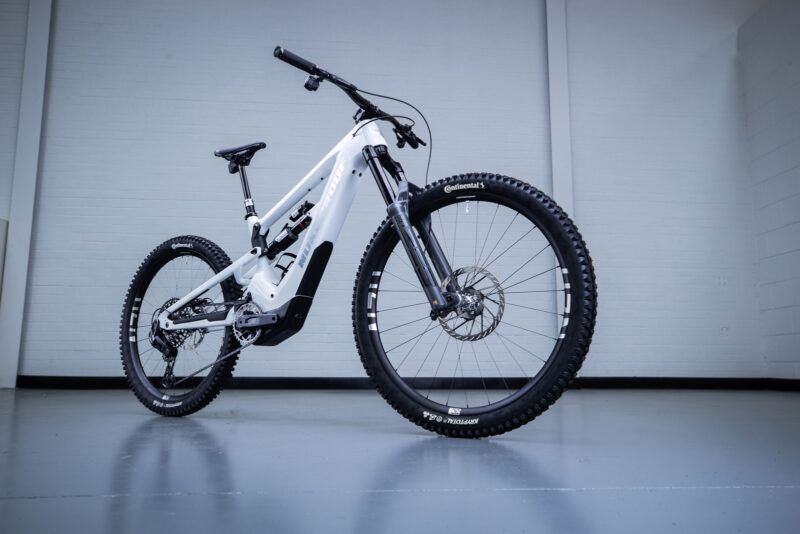
Models, Pricing & Availability
Megawatt Carbon RS – $10,899 USD // 11,999.99 € // £9,999.99
The 2024 Nukeproof Megawatt is available in all sizes, as of today, in the top-end RS model tested here.
That money fetches you a RockShox ZEB Ultimate fork, RockShox Vivid Ultimate shock, and a Nukeproof Horizon PRO wheelset with Continental Kryptotal tires (DH casing). Powertrain is paired with the SRAM XO Transmission with 160mm cranks, with SRAM Code RSC brakes managing speed with the help of a 200mm SRAM HS2 rotor on each end.
Finishing touches include a Rockshox AXS Reverb dropper post topped with a Nukeproof Sam Hill Signature saddle, and a Nukeproof Horizon cockpit with the V2 Carbon bar.
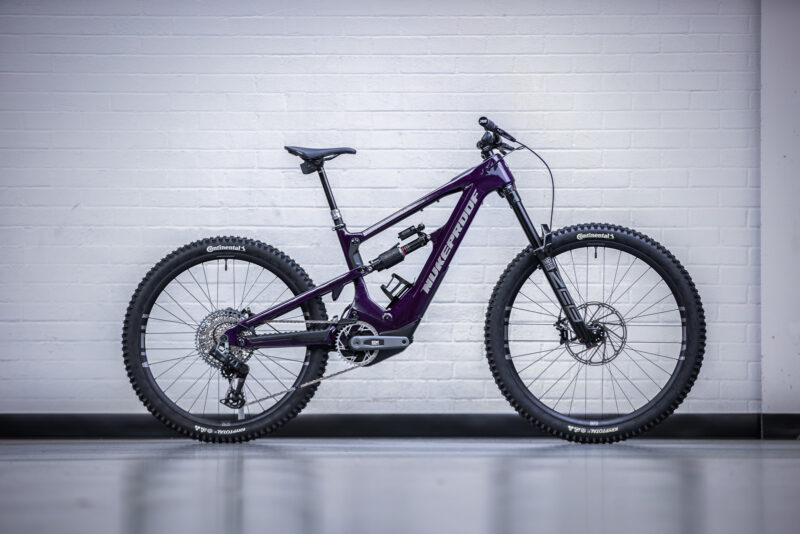
Megawatt Carbon PRO – $9,899 USD // 10,499.99 € // £8,799.99
For the slightly more affordable PRO model, riders will have to wait a month. The above money buys you a Rockshox ZEB Select+, the Vivid Select+, and the Nukeproof Horizon V2 wheelset with the same Continental Kryptotal tire combination. On this one, the drivetrain is slightly downgraded to the SRAM GX Transmission, with SRAM G2 RE brakes clamping 200mm Centerline rotors. All other specs are equivalent.
All carbon Megawatt bikes are sold with a five year warranty on the frame, while the SRAM Eagle Powertrain has a two-year warranty.
